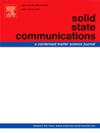Design and optimization of an efficient 2D Dion-Jacobson perovskite/AgInSe solar cells
IF 2.1
4区 物理与天体物理
Q3 PHYSICS, CONDENSED MATTER
引用次数: 0
Abstract
This study proposes an efficient design for 2D Dion-Jacobson Perovskite/Chalcopyrite solar cells, replacing the conventional toxic cadmium sulfide (CdS) electron transport layer (ETL) with a two-dimensional BDAPbBr₄ Dion-Jacobson (DJ) perovskite. Using the SCAPS-1D simulator, the performance of the proposed structure was investigated and compared to experimental results, showing excellent agreement. The findings reveal that the inclusion of the BDAPbBr₄ layer improves the open-circuit voltage (VOC) from 0.5 V in the conventional design to 0.74 V in the optimized device. Additionally, the power conversion efficiency (PCE) increases significantly from 6 % to 10.32 %. These enhancements are attributed to the reduced interface defect density, establishment of a favorable band alignment with a spike-like configuration, and improved light transmission due to the wide bandgap of the BDAPbBr₄ layer. The study further examines the impact of key parameters, including the thickness and doping concentration of the layers, temperature effects, and interface defect density, on device performance. The results underscore the importance of optimizing the ETL properties to mitigate recombination losses and enhance charge carrier extraction. Overall, this work highlights the potential of 2D DJ perovskites as an environmentally friendly and efficient alternative to CdS in Chalcopyrite solar cells, paving the way for greener photovoltaic technologies.
高效二维Dion-Jacobson钙钛矿/AgInSe太阳能电池的设计与优化
本研究提出了一种高效的二维Dion-Jacobson钙钛矿/黄铜矿太阳能电池设计,用二维BDAPbBr₄Dion-Jacobson钙钛矿取代传统的有毒硫化镉(CdS)电子传输层(ETL)。利用SCAPS-1D仿真器对该结构的性能进行了研究,并与实验结果进行了比较,结果吻合良好。结果表明,BDAPbBr₄层的加入将开路电压(VOC)从传统设计的0.5 V提高到优化器件的0.74 V。此外,功率转换效率(PCE)从6%显著提高到10.32%。这些增强是由于降低了界面缺陷密度,建立了有利的带对准与尖峰结构,以及由于BDAPbBr 4层的宽带隙而改善了透光性。该研究进一步考察了关键参数对器件性能的影响,包括层的厚度和掺杂浓度、温度效应和界面缺陷密度。研究结果强调了优化ETL性质对于减少复合损失和提高载流子提取的重要性。总的来说,这项工作强调了2D DJ钙钛矿作为黄铜矿太阳能电池中cd的环保和高效替代品的潜力,为更环保的光伏技术铺平了道路。
本文章由计算机程序翻译,如有差异,请以英文原文为准。
求助全文
约1分钟内获得全文
求助全文
来源期刊

Solid State Communications
物理-物理:凝聚态物理
CiteScore
3.40
自引率
4.80%
发文量
287
审稿时长
51 days
期刊介绍:
Solid State Communications is an international medium for the publication of short communications and original research articles on significant developments in condensed matter science, giving scientists immediate access to important, recently completed work. The journal publishes original experimental and theoretical research on the physical and chemical properties of solids and other condensed systems and also on their preparation. The submission of manuscripts reporting research on the basic physics of materials science and devices, as well as of state-of-the-art microstructures and nanostructures, is encouraged.
A coherent quantitative treatment emphasizing new physics is expected rather than a simple accumulation of experimental data. Consistent with these aims, the short communications should be kept concise and short, usually not longer than six printed pages. The number of figures and tables should also be kept to a minimum. Solid State Communications now also welcomes original research articles without length restrictions.
The Fast-Track section of Solid State Communications is the venue for very rapid publication of short communications on significant developments in condensed matter science. The goal is to offer the broad condensed matter community quick and immediate access to publish recently completed papers in research areas that are rapidly evolving and in which there are developments with great potential impact.
 求助内容:
求助内容: 应助结果提醒方式:
应助结果提醒方式:


